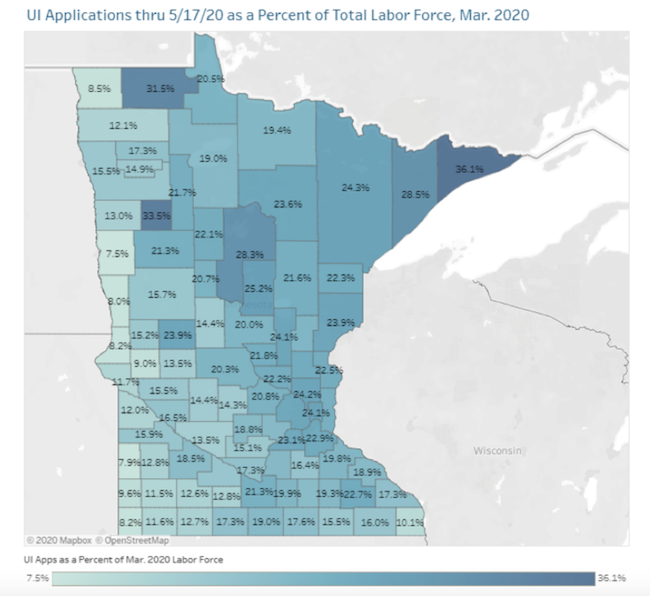
by Carson Gorecki
June 2020
The devastating impacts of the pandemic have been felt throughout the state, yet some areas saw a higher share of the local labor force applying for Unemployment Insurance (UI).

Source: DEED Unemployment Insurance Statistics
More than 660,000 Minnesota workers applied for UI between March 16 and May 17, representing a staggering 21.6% of Minnesota's labor force1 (see Table 1). By comparison, the highest previous two-month total of unemployment claims filed was 102,424, which occurred during the peak of the Great Recession in November and December of 2008. That number represented only 3.5% of the labor force at that time.
Table 1. Unemployment Insurance Applications and Labor Force by Region, March 16 - May 17, 2020
| Region | Number of UI Applications (Mar 16 - May 17) | UI Applications as Percent of Labor Force | Share of State UI Applications (Mar 16 - May 17) | Share of State Labor Force (March 2020) |
|---|---|---|---|---|
| Minnesota | 661,965 | 21.6% | 100.0% | 100.0% |
| Central | 80,663 | 20.5% | 12.2% | 12.8% |
| Northeast | 39,095 | 24.1% | 5.9% | 5.3% |
| Northwest | 54,034 | 18.3% | 8.2% | 9.7% |
| Southeast | 53,521 | 18.9% | 8.1% | 9.2% |
| Southwest | 35,481 | 16.4% | 5.4% | 7.1% |
| Twin Cities | 399,171 | 23.3% | 60.3% | 55.9% |
| Source: DEED UI Statistics, LAUS | ||||
The employment impacts of COVID-19 on Minnesota's workers have not been distributed evenly, neither by geography nor type of work. While much of north central and northeastern Minnesota saw much higher shares of unemployment claims, the southern and western regions saw significantly smaller portions of their labor forces apply for unemployment benefits.
In the counties with the largest shares of UI applications, more than a quarter of the labor force applied for benefits as of May 17. Northwestern counties Mahnomen (33.5%) and Cass (28.3%) as well as Cook (36.1%) and Lake (28.5%) in Northeast Minnesota had the highest shares of claims. At the other end of the spectrum, western counties Clay (7.5%), Lincoln (7.9%), Wilkin (8.0%), Rock (8.2%), and Traverse (8.2%) all saw around eight% of their labor force apply for unemployment insurance.
Although Greater Minnesota is home to both the highest and lowest relative shares of UI applications as a percent of the labor force, the seven-county metro region accounted for 60.3% of the state's claims. Just over 23% of the metro's labor force of 1.7 million workers filed for UI from March 16 to May 17, the second highest share of any region.
Those counties with the highest percentage of UI applications shared high concentrations in severely-impacted industries, particularly leisure and hospitality. Statewide, 10% of jobs were in the leisure and hospitality sector in 2019, whereas the three counties with the highest shares of UI applications had more than a quarter of their jobs in leisure and hospitality. In the two hardest-hit counties, Mahnomen and Cook, more than two out of every five jobs were in leisure and hospitality. Across the state, tourism-based economies have been particularly susceptible to the effects of pandemic containment measures.
The areas that exhibited lower shares of UI applications, in the western and southwestern parts of the state, tended to have higher concentrations in the manufacturing and agriculture industries that were mostly deemed critical industries or met social distancing requirements and continued operation throughout the shutdown.
The impacts of the coronavirus response on Minnesota's labor force have been devastating and unprecedented. As we begin to work toward recovery, we will likely not know the true effects for some time. The Labor Market Information Office will continue to provide the most current information to track trends, especially at the regional and local level.
1LAUS, March 2020